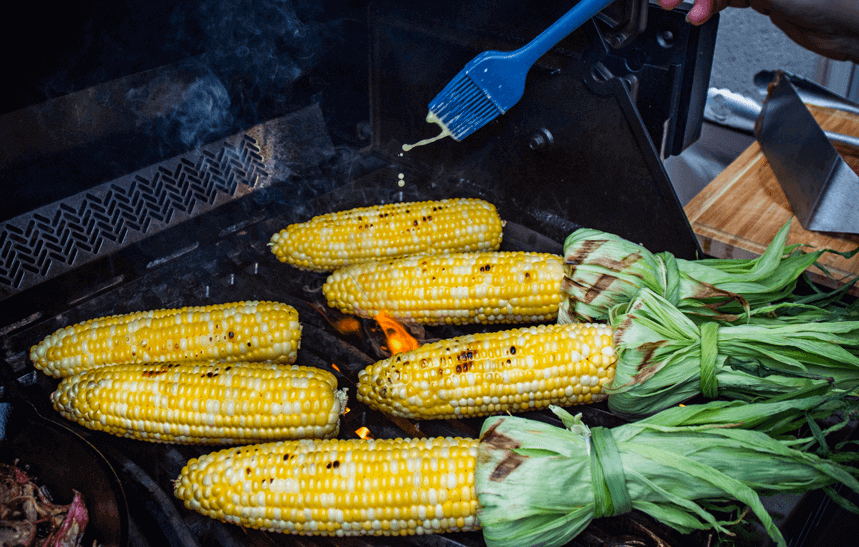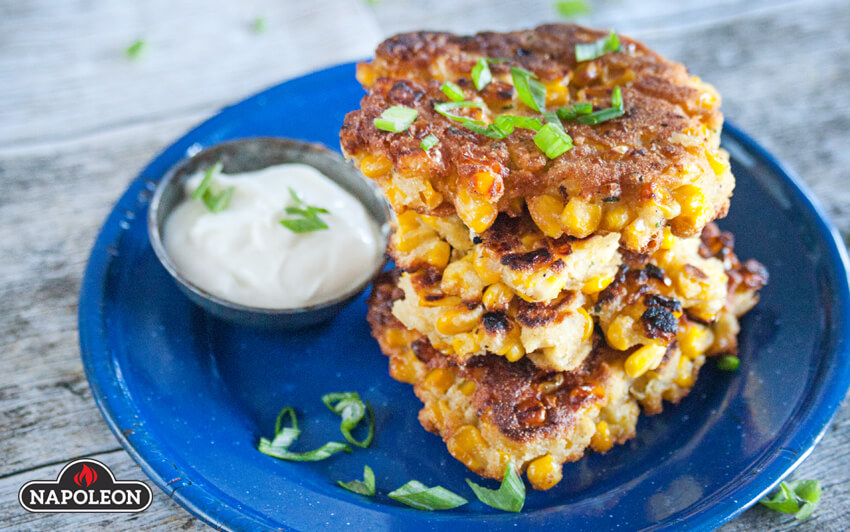
The Secret to Picking the Best Corn on the Cob
Do you know the secrets to picking the best corn on the cob? We do! In this Napoleon BBQ Blog we’ll share those kernels of truth with you and make sure that you’re getting the best your cobs have to offer. Please forgive any corny jokes as you read through this article, though, we know we’re going to get an ear-full. Read on and shuck the lies so that you can enjoy the best that corn has to offer.
What is Corn?
Corn is an edible grain and vegetable that is high in thiamin (a B vitamin), Vitamin C, Potassium, fiber, and protein. This starchy veg consists of delicious kernels attached to a woody cob. The average cob of corn is about 130 calories with 1.8 grams of fat before adding butter, salt, and pepper. They are coated in cornsilk – a threadlike substance that somehow sticks to everything, with an outer husk of soft green leaves. The whole plant is useful, not just the tasty nuggets. The stalk is often used as livestock feed. The cornsilk can be used in tea, the husk can wrap tamales and other foods for steaming. And finally, the woody cob can be used in soups and stews to thicken and add flavour. Many different varieties of corn are used in many ways, but this article is specifically about the sweet corn that you eat off the cob.

The Secret to Picking the Best Corn on the Cob
Before you cook those delicious corn to go with your amazing barbecued meals you need to know how to pick the best corn on the cob.
- When you are in the store, look for husks that are green and tight to the cob. Anything loose, dry, brown, or moldy are no good. Gently squeeze and check for soft spots.
- Check on the cornsilk. Light green, pale gold, and/or white are great colours to see. If it’s dried out, mushy, black or brown, that is not ideal. The ends will definitely begin to discolour, but when the silk is discoloured very close to and INSIDE the cob, that is what you are looking for and want to avoid.
- Feel the weight of the corn in your hand. A super juicy and flavourful cob will have some heft, it will feel heavier and plump.
- Peel back a little bit of the husk at the top. The kernels should come all the way up to the top of the cob. They should be plump and juicy looking, not discoloured or mushed in.
If you check all of these boxes, you should have yourself a near-perfect ear of corn to enjoy.
Don't Shuck Corn in Store
Shucking in store makes a mess and is rude to the staff and other customers who wish to purchase corn too. Shucking before you are ready to cook and eat fresh corn begins the deterioration process and if you don’t eat it within a couple of hours of shucking, you will have wasted all of that effort to find those perfect cobs. Furthermore, please don’t pop kernels with your nails to test freshness. If you dislike that ear of corn and put it back, you’ve damaged ones that others may like to purchase.

The corn on the left has been pre-shucked, packaged on a tray and vacuum sealed. The corn on the right is fresh, just purchased and shucked.
How Should You Store Corn?
Corn is best eaten fresh but will last up to a week if stored properly in the fridge. Fresh corn can last longer when frozen too. Here’s how to store corn for maximum enjoyment.
When you have found the perfect cobs and purchased them, you can store them in your vegetable crisper in the fridge for up to a week. If you are camping or at the lake house or cottage, keep the corn cool and a little moist, so a cooler will also work. You can leave them loose or keep them in the bag you purchased them in. Leave the husks on. Remember. The sooner you eat the corn, the sweeter it will be as the sugars that make corn sweet will turn into starch as time passes.

Corn Fritters
Have some fresh corn that needs to be used before it’s too old? Try these delicious corn fritters a great side dish to pair with your dinners.
When is Corn Season?
Sweet corn is available from mid-May to September in the United States. Although it is very tempting, try not to buy corn out of season. Whole corn on the cob will be tasteless, starchy, and even dry during off-peak months.
Like other hyper-seasonal produce, corn is at its peak from mid-May to September. If you really enjoy it purchase some extra throughout the season and freeze it. You can blanch the whole cobs that have been shucked, seal them into airtight containers, and freeze them. Alternatively, you can blanch the cobs, then cut the kernels away and freeze them in an airtight container for fresh sweet corn enjoyment year-round.
Learn more about fresh versus frozen foods and how to prepare foods for the freezer.
Corn Hack
When removing kernels from the cob, place the cob, on a cutting board and carefully run a sharp knife down the cob, freeing kernels. For an even easier time with less cleanup, use a bundt pan with the stack and hole in the top. Place the small end of the corn into the hole in the bundt pan’s stack and run the knife behind the kernels. They will land in the pan for mess-free corn.

How to Cook Corn on the Cob
There are several ways to cook corn on the cob. Everyone has their way of doing it.
- Traditionally, you can shuck the corn and boil it for 4 to 7 minutes, until the yellow colour deepens.
- Steam-shucked corn on a raised platform, in a pot, for 10 to 12 minutes.
- On the BBQ, leave the corn in the husk and soak them for 30 minutes. Then, using medium, indirect heat, cook the corn for 30 to 60 minutes, until the yellow is deep and the kernels are tender.
- On the BBQ again. Alternatively, you can shuck the corn and BBQ it over direct heat until sear marks appear, and the colour deepens to a dark yellow. In the final minutes, baste with a little butter, being careful of flare-ups.

How to Serve Corn
You can do anything you want with corn on the cob. Traditionally, in North America, it is served with butter, salt, and pepper. Other places around the world serve corn topped with Mexican cheese and spicy peppers in Elotes style. Try a miso-chili butter and squeeze of lime, consider also different seasonings like Japanese Furikake, Chili crisp, and even Tajin instead.
If you cut the kernels away from the cob itself, you can also use corn in other recipes like nachos, salads, soups, for creamed corn, salsa, and even fritters. What is your favourite way to eat fresh corn on or off the cob?

Street Corn Nachos with Smoked Beef
Try this street corn nachos recipe for an exciting way to devour fresh corn on the cob.
People Also Asked:
How Do You Choose Corn on the Cob
When selecting corn in-store, choose cobs with green, tight husks, avoiding any that are loose, brown, or moldy. Check the cornsilk, ensuring it is light green, pale gold, or white; avoid any that is dried out, black, or brown, especially near the cob. Opt for cobs that feel heavy and plump, with kernels that reach the top, appearing juicy and undamaged.
How Do You Know if Corn on the Cob is Good?
You know you have the best corn on the cob when you pick up an ear that is weighty for its size. The husk should be green, tight, and healthy. The silk will be a little brown on the ends but mostly golden-white. If you peel back a little husk, the kernels are plump and come to the top. That is how you know that you have picked the best corn on the cob.
What is the Best Way to Store Fresh Corn on the Cob?
To properly store fresh corn on the cob, keep it in the vegetable crisper of your fridge for up to a week, leaving the husks on. If you're camping or at a cottage, store the corn in a cool, slightly moist place, such as a cooler.
Is it Better to Store Corn With or Without the Husk?
The husk on a fresh corn on the cob acts as a protective barrier to the naturally occurring ethylene gas released by fruits and vegetables. This keeps corn on the cob fresher longer, however, you only want to store fresh corn for up to a week before eating it to get the best experience.
How Much Time Do You Boil Corn on the Cob?
Boil corn on the cob for 4 to 7 minutes, depending on the size and freshness of the corn. The kernels should be tender but still slightly crisp when done. Be sure to add the corn to boiling water and cook just until the vibrant yellow colour deepens, indicating it's ready to enjoy.
Share Your Corn Recipes with Us!
Now that you know the secrets to picking the best corn on the cob, storing, cooking, and even some hacks, thanks to this Napoleon BBQ Blog, are you excited for your next backyard barbecue? Will you be including corn on the cob? Tell us your favourite ways to enjoy corn by sharing your stories, recipes, and photos with us on social pages like our Facebook and Tiktok pages using the hashtags #NapoleonEats and #NapoleonBBQs.

Show us what you are grilling
Join the #NapoleonEats Community on Social